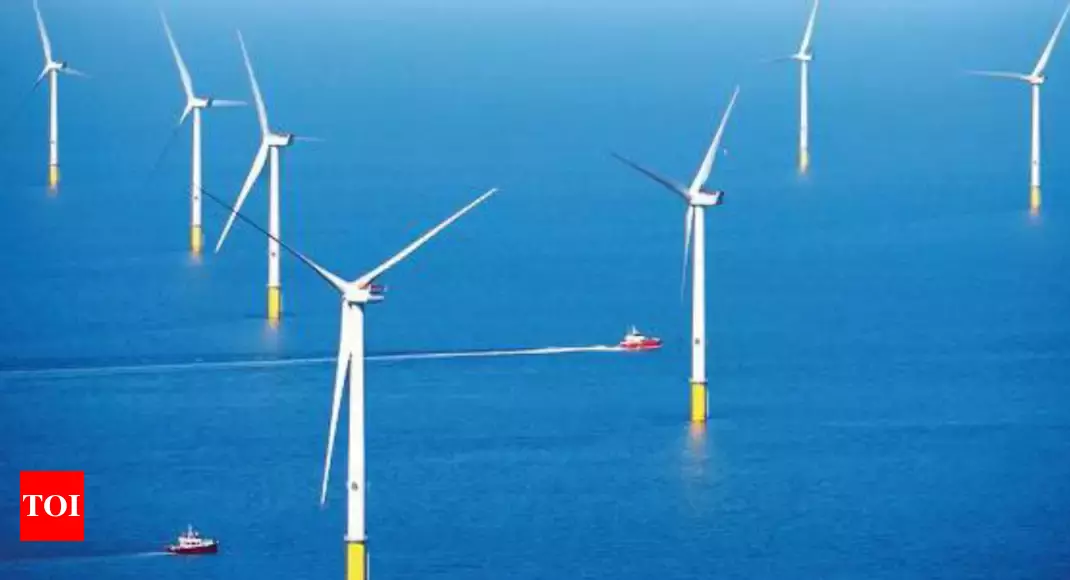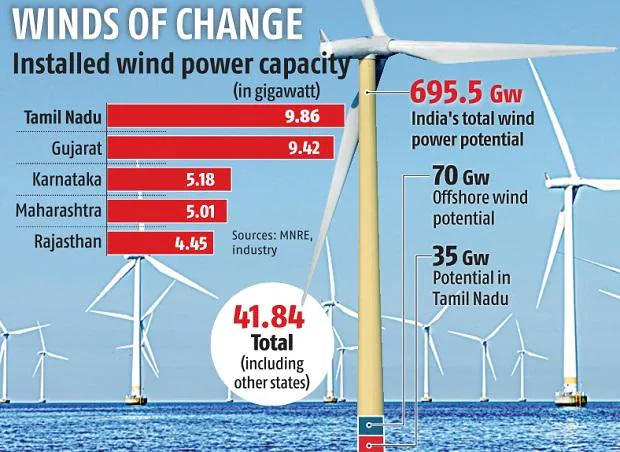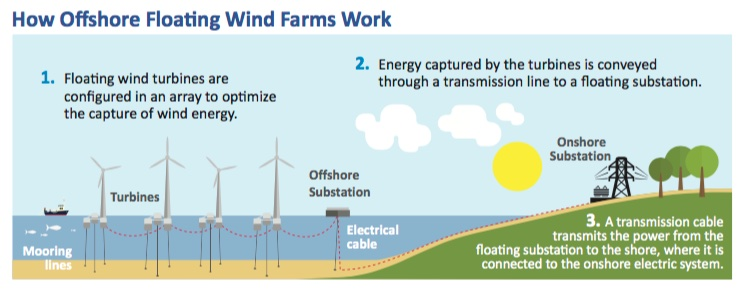Description

Copyright infringement not intended
Picture Courtesy: The Times of India
Context: India's efforts to harness offshore wind energy as a part of its renewable energy expansion strategy
Key Highlights
- Introduction of Offshore Wind Energy Policy: India introduced the National Offshore Wind Energy Policy in 2015 to promote the development of offshore wind energy within the nation's Exclusive Economic Zone (EEZ) up to 200 nautical miles from the coastline. The policy aimed to provide a regulatory structure for offshore wind energy growth.
- Multi-Model Approach: The Union Ministry of New and Renewable Energy (MNRE) is the nodal ministry, while the National Institute of Wind Energy (NIWE) serves as the nodal agency to oversee offshore wind energy initiatives. Despite the policy, progress in the offshore wind sector has been slow over the past few decades.
- Identification of Offshore Wind Zones: A multi-criteria approach was used to identify areas with high potential for offshore wind energy, involving factors like wind resources and water depth measurements. The southern tip and west coast regions were found to be promising for offshore wind farm development. Eight zones off the coasts of Gujarat and Tamil Nadu were identified as potential offshore wind energy zones.
- Government Agencies and Plans: The Ministry of New and Renewable Energy (MNRE) and the National Institute of Wind Energy (NIWE) are responsible for conducting studies, creating policies, and implementing financial incentives to encourage private sector investment in offshore wind power projects. India plans to auction 37 gigawatts of offshore site leases over the next seven years, with different phases and capacities each year.

Picture Courtesy: business-standard.com
Offshore Wind Energy in India
About
- Offshore wind energy refers to the harnessing of wind power from turbines installed in bodies of water, typically in seas or oceans. It involves the construction of wind farms with multiple turbines located offshore to capture the kinetic energy of wind and convert it into electricity.
- Offshore wind energy has gained prominence as a clean and renewable energy source, offering several advantages over onshore wind, such as higher wind speeds and a reduced visual impact on landscapes.
Mechanism: Offshore wind energy works through the following steps:
Turbine Installation
- Offshore wind turbines are strategically placed in water bodies to capture the kinetic energy of the wind and convert it into electricity.
- Site Selection: The first step is selecting suitable locations for installing offshore wind turbines. Factors considered include wind resource quality, water depth, proximity to the grid, and environmental impact assessments.
- Foundation Types: Depending on the water depth and seabed conditions, different types of foundations are used:
- Fixed Foundations: These are similar to foundations used in onshore wind turbines. They are embedded into the seabed to provide stability for the turbine.
- Floating Platforms: In deeper waters where fixed foundations are not feasible, floating platforms are used. These platforms are anchored to the seabed and allow turbines to operate in varying water depths.
- Submerged Structures: These innovative structures are partially submerged and are designed to capture wind energy at different heights above the water surface.
- Turbine Installation: Once the foundation is in place, the turbine components are assembled and lifted onto the foundation using specialized vessels and equipment. This includes the tower, nacelle (housing the generator and other machinery), and rotor assembly (blades).
Electricity Generation
- Once the turbines are installed and operational, the process of electricity generation begins.
- Wind Energy Capture: As the wind blows, it causes the turbine blades to rotate. The design of the blades is optimized to capture the maximum amount of wind energy at different wind speeds.
- Rotor and Generator: The rotation of the blades is transferred to the rotor in the nacelle. The rotor is connected to a generator, which converts the mechanical energy into electrical energy through electromagnetic induction.
- Electromagnetic Induction: Inside the generator, the rotor's rotation creates a magnetic field that interacts with coils of wire, inducing an electrical current. This current is an alternating current (AC) with a frequency determined by the rotor's rotation speed.
Transmission
- After electricity is generated, it needs to be transported to the onshore grid for distribution.
- Substation: The electricity generated by multiple turbines is collected at an offshore substation. This substation transforms the generated electricity to a higher voltage level, making it suitable for long-distance transmission.
- Undersea Cables: High-voltage undersea cables are used to transmit the electricity from the offshore substation to the onshore substation. These cables are designed to withstand the marine environment and are usually buried or protected on the seabed.
- Onshore Substation: The undersea cables are connected to an onshore substation, where the voltage is further transformed to match the grid's voltage. At this stage, the electricity is ready for distribution to consumers and industries.
- Grid Integration: The electricity is integrated into the national or regional grid, where it becomes part of the overall electricity supply. It can be used to power homes, businesses, and various other applications.

Picture Courtesy: pasoroblespress.com
Significances of Offshore Wind Energy in India
Renewable Energy Growth
- Climate Mitigation: Offshore wind power is a clean and renewable energy source that produces minimal greenhouse gas emissions. By replacing fossil fuel-based energy sources, it helps reduce India's carbon footprint and contributes to global efforts to mitigate climate change.
- Meeting Renewable Targets: India has set ambitious renewable energy targets as part of its commitment to the Paris Agreement. Offshore wind power offers a valuable avenue to meet these targets, diversifying the renewable energy portfolio beyond solar and onshore wind.
Energy Security
- Reduced Fuel Imports: India currently relies on coal, oil, and natural gas imports to meet a significant portion of its energy needs. Offshore wind power reduces this dependence, thus improving energy security and reducing vulnerability to international energy price fluctuations.
- Domestic Energy Production: Generating electricity from offshore wind within India's maritime boundaries reduces the need to rely on foreign energy sources, contributing to energy self-sufficiency.
Job Creation
- Skilled and Unskilled Jobs: Offshore wind projects require a range of expertise, from engineering and construction to operations and maintenance. This leads to the creation of both skilled and unskilled jobs.
- Local Employment: Offshore wind projects can stimulate economic growth in coastal regions by creating local job opportunities, supporting local communities, and boosting ancillary industries such as logistics and marine services.
Technological Innovation
- Foundation Design: Offshore wind farms require innovative foundation designs to withstand the harsh marine environment, different water depths, and seabed conditions.
- Floating Platforms: In deeper waters where traditional fixed foundations are not feasible, floating platforms present an innovative solution to support offshore turbines.
- Undersea Transmission Systems: The design and deployment of undersea cables for transmitting electricity from offshore turbines to onshore substations require technical innovation to ensure reliability and efficiency.
- Remote Monitoring and Maintenance: Developing technologies for remote monitoring and maintenance of offshore turbines and platforms can lead to cost savings and operational efficiencies.

Steps Taken by India
National Offshore Wind Energy Policy (2015)
- In 2015, India introduced the National Offshore Wind Energy Policy to establish a framework for the development of offshore wind energy within the country's Exclusive Economic Zone (EEZ) up to 200 nautical miles from the coastline. This policy aimed to provide a clear roadmap and regulatory structure for the growth of offshore wind energy.
- Regulatory Framework: The policy laid out guidelines for obtaining permits, clearances, and licenses required for offshore wind projects. It established a comprehensive regulatory framework to streamline the approval process and ensure compliance with environmental and safety standards.
- Incentives: To attract private investments and project developers, the policy offered various incentives, including financial incentives, tax benefits, and favourable tariff structures.
- Zonal Allocation: The policy identified specific zones within the EEZ that were deemed suitable for offshore wind development. These zones were selected based on factors such as wind potential, water depth, and environmental considerations
NIWE (National Institute of Wind Energy)
- The National Institute of Wind Energy (NIWE) was designated as the nodal agency responsible for coordinating and facilitating offshore wind energy initiatives in India.
- Feasibility Studies: NIWE conducted detailed feasibility studies to assess the wind resource potential, environmental impact, and technical feasibility of offshore wind projects. These studies helped identify viable project locations and understand the challenges associated with offshore wind development.
- Research and Development: NIWE is involved in research and development activities related to offshore wind technology, including foundation designs, grid integration, and environmental impact assessment methodologies.
- Capacity Building: NIWE has been instrumental in building technical capacity and expertise in the offshore wind sector through training programs, workshops, and knowledge sharing with industry stakeholders and experts.
Feasibility Studies
- Wind Resource Assessment: Comprehensive wind resource assessment studies were conducted to identify areas with high wind energy potential, taking into account seasonal and spatial variations.
- Environmental Impact Assessment: These studies assessed the potential impacts of offshore wind projects on marine ecosystems, wildlife, and local communities, ensuring that projects adhere to environmental regulations.
- Technological Viability: Feasibility studies evaluated the technical feasibility of offshore wind projects, considering factors like water depth, foundation types, and transmission infrastructure.
Collaborations
- India collaborated with international players and organizations to leverage their expertise and experience in offshore wind technology.
- Knowledge Sharing: Collaborations with countries like Denmark, the United Kingdom, and Germany allowed India to learn from their experiences in developing and operating offshore wind farms.
- Technology Transfer: International collaborations facilitated the transfer of advanced offshore wind technology, including innovative foundation designs, floating platform concepts, and grid integration solutions.
- Global Best Practices: By collaborating with established offshore wind markets, India gained insights into best practices, regulatory approaches, and strategies for overcoming challenges.
Challenges
High Initial Costs
- Capital-Intensive: Offshore wind projects involve substantial costs for various components such as turbines, foundations, subsea cables, and infrastructure development. These high initial costs can pose financial challenges.
- Uncertainty: The capital-intensive nature of offshore wind projects can make investors cautious due to uncertainties related to return on investment, project delays, and technological risks.
- Financing Challenges: Securing financing for large-scale projects can be challenging, particularly when compared to more established forms of energy generation.
Infrastructure Development
- Port Infrastructure: Developing ports capable of handling the transportation, assembly, and maintenance of offshore wind components is essential but can involve significant time and investment.
- Specialized Vessels: Offshore wind projects require specialized vessels for turbine installation, maintenance, and cable laying. Building or retrofitting these vessels can be costly.
- Grid Connections: Connecting offshore wind farms to onshore substations and the national grid requires the installation of undersea cables and grid infrastructure, which can be technically challenging and expensive.
Regulatory Complexities
- Multiple Approvals: Offshore wind projects require approvals from multiple regulatory bodies, including environmental agencies, maritime authorities, and local governments. The lengthy approval process can lead to delays.
- Environmental Regulations: Due to the sensitive marine ecosystem, offshore wind projects must adhere to stringent environmental regulations, which can add to the complexity of the approval process.
- Land Use and Zoning: Balancing offshore wind development with other maritime activities such as shipping, fishing, and conservation efforts requires careful zoning and coordination among stakeholders.
Environmental Concerns
- Marine Ecosystem Impact: The installation and operation of offshore wind farms can disrupt marine ecosystems through habitat displacement, underwater noise, and changes in water quality.
- Wildlife Interaction: Turbine installations and cable laying activities can potentially impact marine life, including fish, mammals, and birds. Collisions and disturbance to migratory routes are concerns.
- Visual and Aesthetic Impact: While offshore wind farms have reduced visual impact compared to onshore ones, they can still raise concerns among local communities and recreational users of coastal areas.
- Community Engagement: Addressing local communities' concerns and engaging stakeholders in the planning and decision-making process is crucial to ensuring project acceptance and minimizing conflicts.
Way forward
Technology Development
- Continuous research and development (R&D) efforts are vital to advancing offshore wind technology and making it suitable for India's unique conditions.
- Adaptation: Offshore wind technology needs to be adapted to suit the varying wind and water conditions of India's coastline, which can involve modifying turbine designs, foundation systems, and transmission infrastructure.
- Innovation: R&D efforts can drive innovation in areas such as floating platforms, foundation design for different seabed conditions, corrosion protection, and offshore grid integration.
- Collaboration: Collaboration between research institutions, industry players, and international experts can help accelerate the development and deployment of new technologies.
Policy Support
- Clear and supportive policies play a crucial role in attracting investments and expediting offshore wind projects
- Stable Regulatory Framework: Continuity in policies and regulatory certainty is essential to provide confidence to investors and project developers.
- Incentive Mechanisms: Implementing financial incentives, tax benefits, and favourable tariff structures can encourage private sector participation and enhance project viability.
- Streamlined Approvals: Simplifying and expediting the approval process for permits, clearances, and licenses can reduce delays and encourage project implementation.
Infrastructure Investment
- Investments in infrastructure are essential to support the growth of offshore wind energy.
- Port Facilities: Developing dedicated port facilities equipped for manufacturing, assembly, and maintenance of offshore wind components can reduce logistical challenges.
- Transmission Infrastructure: Establishing robust undersea cable systems and onshore substations is crucial for efficient electricity transmission and grid integration.
Capacity Building
- Building local expertise and human resources is important for the sustainable growth of the offshore wind sector.
- Training Programs: Developing training programs that offer specialized education in offshore wind technology, project management, and operations can create a skilled workforce.
- Knowledge Sharing: Collaborating with international experts and sharing experiences can help build a knowledge base and avoid reinventing the wheel.
Stakeholder Engagement
- Engaging local communities, environmental groups, and other stakeholders is essential for project acceptance and success.
- Early Engagement: Involving stakeholders from the project's conceptual stage can address concerns, mitigate conflicts, and ensure that projects are aligned with local needs.
- Transparency: Providing transparent information about project impacts, benefits, and mitigation measures helps build trust and understanding among stakeholders.
International Collaboration
- Leveraging global experience and collaboration can accelerate India's offshore wind journey.
- Learning from Others: India can benefit from the experiences of established offshore wind markets by studying their successes and challenges.
- Technology Transfer: Collaborating with countries and organizations that have advanced offshore wind technology can help India adopt best practices and innovative solutions.
- Policy Exchange: Engaging in international forums and policy dialogues can help India align its offshore wind policies with global trends and standards.

Conclusion
- Offshore wind energy holds immense potential for India's renewable energy landscape. Despite challenges, strategic planning, technological advancement, and strong policy support can pave the way for a cleaner, more sustainable energy future in the country.
Must Read Articles:
WIND ENERGY IN INDIA: https://www.iasgyan.in/daily-current-affairs/wind-energy-in-india#:~:text=India%20has%20set%20an%20annual,wind%20motion%20to%20generate%20electricity.
|
PRACTICE QUESTION
Q. How does wind energy contribute to a sustainable energy future? Discuss its significance as a renewable source, highlight the challenges hindering its widespread adoption, and outline potential strategies for overcoming these challenges and advancing wind energy as a key component of the global energy transition.
|
https://www.downtoearth.org.in/blog/energy/offshore-wind-energy-india-set-to-harness-coastal-breezes-91428















